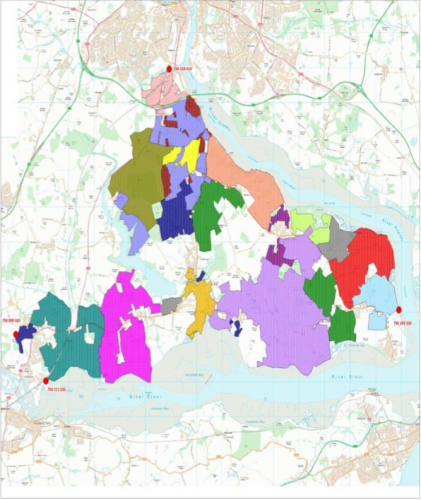Ref: CSFF090007
Lead: AJ, aj@broxtead.com
Group members: 17
Length of agreement: 5
Area of group (Hectares): 4252
Priorities
To help restore/maintain the Orwell and Stour Estuaries SPA, Ramsar and SSSI sites and Special Areas of Conservation, Freston and Cutlers Woods with Holbrook Park SSSI; Alton Water CWS, Holbrook Bay CWS, Holbrook Gardens CWS and several woodland CWS; to protect the unique landscape characteristic and increase biodiversity:
1. Maintain, restore or enlarge priority habitats:
- Dry acid grassland
- Lowland heathland [remnant]
- Lowland meadows
- Coastal & floodplain grazing marsh
- Saltmarsh
- Intertidal mudflats
- Reed Riparian habitats
- Traditional orchards
- Deciduous woodland
- Ancient woodland
- Veteran/Oak Boundary Trees
- Arable field margins
- Wood-pasture and Parkland
2. Provide/improve habitat for the following:
- Arable – Lapwing, Barn Owl, Corn Bunting, Turtle Dove, Tree Sparrow [Tattingstone], Grey Partridge[ Brantham, Stutton ], Reed Bunting Yellow Wagtail and Linnet.
- Woodland – Marsh Tit, Spotted Flycatcher, Tree Creeper, Lesser Spotted Woodpecker, Nightingale, Lesser Redpoll .
- Breeding Waders – Curlew, Black-tailed Godwit, Snipe, Oystercatcher, Redshank, Little Grebe.
- Arable plant assemblage – Corn Marigold, Corn Spurrey, Small-flowered catch fly, Sticky catchfly, Pearlwort.
- Saltmarsh plant assemblages.
- Hazel Dormouse
- Stag Beetle
To enhance arable/grassland habitat, increase biodiversity and provide corridors for species to move freely during climatic change:
- Establish nectar and wild bird seed plots and upgrade grassy field corners/margins into flower rich areas
- Create fallow plots for breeding lapwing, stone curlew / rare arable plants
- Leave small bare areas near field edges and alongside track ways
- Restore hedgerows
- Improve grassland management and maintain/restore historic parkland
To improve water quality, reduce soil erosion, and preserve landscape features:
- Control the source/ movement of pollutants (nutrient, sediment and pesticides), surface water and sediments
- Improve soil management particularly in relation to outdoor pigs
- Buffer wetland habitat such as coastal and floodplain grazing marsh and reedbed
- Use green cover on arable fields
- Improve riparian management
To help maintain the unique landscape, improve water quality, increase biodiversity, lower flood risk and offset climate change effects:
- Actively manage woodland
- Work together to control bracken and invasive non-native species
- Buffer historic features
- Maintain/restore historic parklands
- Buffer historic features

